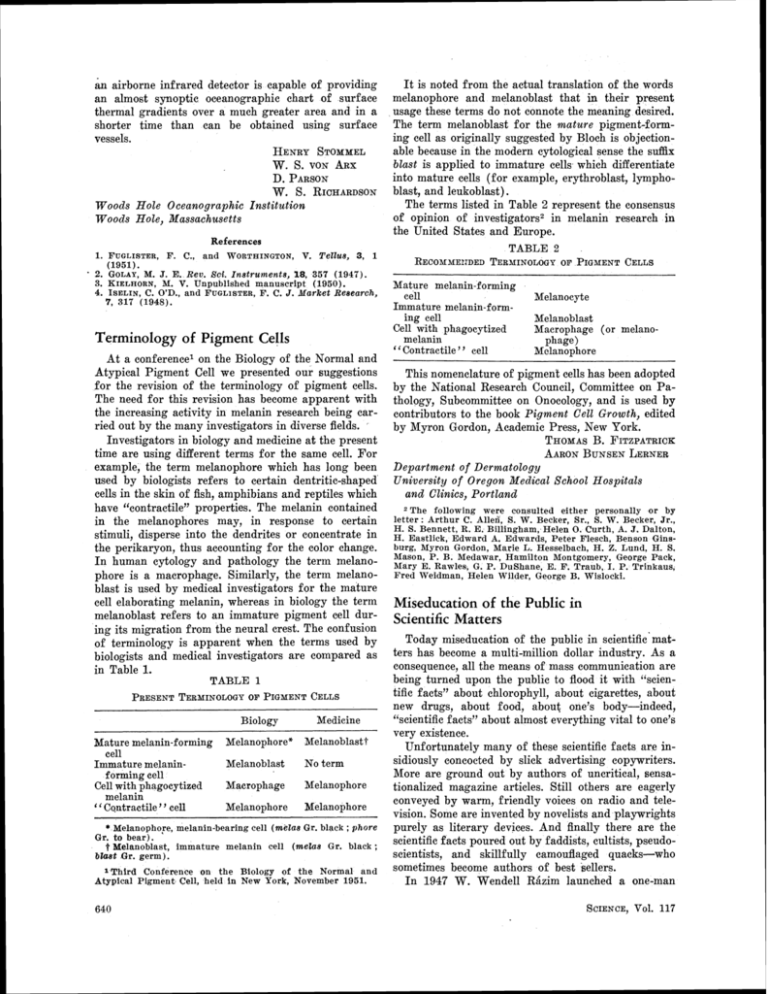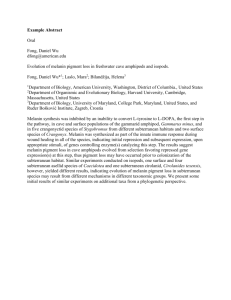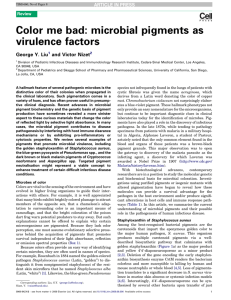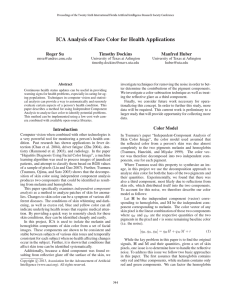Terminology of Pigment Cells
advertisement

&I airborne infrared detector is capable of providing an almost synoptic oceanographic chart of surface thermal gradients over a much greater area and in a shorter time than can be obtained using surface vessels. HENRYSTOMMEL W. S. VON ARX It is noted from the actual translation of the words melanophore and melanoblast that in their present usage these terms do not connote the meaning desired. The term melanoblast for the mature pigment-forming cell as originally suggested by Bloch is objectionable because in the modern cytological sense the suffix blast is applied to immature cells which differentiate into mature cells (for example, erythroblast, lymphoD. PARSON W. S. RICHARDSON blast, and leukoblast) . The terms listed in Table 2 represent the consensus W o o d s Hole Oceanographic Institution of opinion of investigatorsqn melanin research in W o o d s Hole, Massachusetts the United States and Europe. References TABLE 2 1 . F UGLISTER,F. C., and mr0RTHINGTON, V. Tellus, 3, 1 RECON~IEITDED TERNINOLOGY O F PIGXENT CELLS (1951). 2. GOLAY,M. J. E. Rev. Scl. Instruments, 18, 357 ( 1 9 4 7 ) . 3. KIELHORN, &I.V. Unpublished manuscript ( 1 9 5 0 ) . 4 . ISELIN,C. O'D., and FUGLISTER, F. C. J. Yarlcet Research, 7 , 317 ( 1 9 4 8 ) . Terminology of Pigment Cells At a conference1 on the Biology of the Normal and Atypical Pigment Cell we presented our suggestions f o r the revision of the terminology of pigment cells. The need f o r this revision has become apparent with the increasing activity in melanin research being carried out by the many investigators in diverse fields. Investigators in biology and medicine a t the present time are using different terms f o r the same cell. F o r example, the term melanophore which has long been used by biologists refers to certain dentritic-shaped cells in the skin of fish, amphibians and reptiles which have "contractile" properties. The melanin contained in the melanophores may, in response to certain stimuli, disperse into the dendrites or concentrate in the perikaryon, thus accounting f o r the color change. I n human cytology and pathology the term melanophore is a macrophage. Similarly, the term melanoblast is used by medical investigators for the mature cell elaborating melanin, whereas in biology the term melanoblast refers to an immature pigment cell during its migration from the neural crest. The confusion of terminology is apparent when the terms used by biologists and medical investigators are compared as in Table 1. TABLE 1 M a t u r e melanin-forming cell I m m a t u r e melaninform in^ eel1 Cell with ihagocytized melanin Cqntraetile cell '' " Biology Medicine Melanophore* Melanoblasti Melanoblast No term Maerophage Melanophore Melanophore Melanophore * Melanopho,re, melanin-bearing cell (melas Gr. black ; phore Gr. to bear). t Melanoblast, immature melanin cell (melas Gr. black ; blast Gr. germ ) . =Third Conference on the Biology of the Normal and Atypical Pigment Cell, held in New York, November 1951. M a t u r e melanin-forming cell I m m a t u r e melanin-formi n g cell Cell with phagocytized melanin cell "Contractile ' Melanocyte hfelanoblast Macrophage (or melanophage) Molano~hore This nomenclature of pigment cells has been adopted by the National Research Council, Committee on P a thology, Subcomnlittee on Onocology, and is used by contributors to the book Pigment Cell Growth, edited by Myron Gordon, Academic Press, New York. THOMASB. FITZPATRICK AARONBUNSENLERNER Department of Dermatology University of Oregon Medical School Hospitals and Clinics, Portland 2 T h e following were consulted either personally or by letter: Arthur C. Allen, S. W. Becker, Sr., S. \V. Becker, Jr., H. S. Bennett, R. E. Billingham, Helen 0.Curth, 8. J . Dalton, H. Eastlick, Edward A. Edwards, Peter Flesch, Benson Ginsburg, Myron Gordon, Marie L. Hesselbach, H. Z. Lund, H. S. Mason, P. B. Medawar, Hamilton Montgomery, George Pack, Mary E. Rawles, G . P. DuShane, E. F. Traub, I . P. Trinkaus, Fred Weidman, Helen Wilder, George B. Wislocki. Miseducation of the Public in Scientific Matters Today miseducation of the public in scientific matters has become a multi-million dollar industry. As a consequence, all the means of mass communication are being turned upon the public to flood it with '(scientific facts" about chlorophyll, about cigarettes, about new drugs, about food, about one's body-indeed, "scientific facts" about almost everything vital to one's very existence. Unfortunately many of these scientific facts are insidiously concocted by slick advertising copywriters. More are ground out by authors of uncritical, sensationalized magazine articles. Still others are eagerly conveyed by warm, friendly voices on radio and television. Some are invented by novelists and playwrights purely as literary devices. And finally there are the scientific facts poured out by faddists, cultists, pseudoscientists, and skillfully camouflaged quacks-who sometimes become authors of best sellers. I n 1947 W. Wendell Riizim launched a one-man











